(3) Quality Education for All
Education plays an important role in the socio-economic development that is needed for poverty reduction. It also enables individuals to develop their potential and capability, as well as to live with dignity. Education fosters understanding of other people and different cultures, and forms the foundation for peace. However, approximately 57 million children worldwide are still out of school, despite the fact that achieving universal primary education was one of the MDGs with the target date of 2015. Furthermore, new problems have been indicated. For example, in countries and regions affected by conflict, the proportion of out-of-school children that was 30% in 1999 increased to 36% in 2012. (Note 18)
To improve this situation, the Incheon Declaration that compiles recommendations for education beyond 2015 was unveiled at the World Education Forum 2015* held in Incheon, the Republic of Korea in May 2015. The Declaration urges the international community to make efforts to expand access to education.
In the 2030 Agenda was adopted at the UN to succeed the MDGs. Goal 4 of the SDGs is identified as “Ensure inclusive and equitable quality education and promote lifelong learning opportunities for all,” in order to address the education goal from the MDGs, which remains unachieved.
The international community has been committed to realizing Education for All (EFA).* Following EFA, in order to achieve the more comprehensive Goal 4, the Education 2030 Framework for Action* was adopted at the Education 2030 High-Level Meeting held in November 2015.
<Japan’s Efforts>
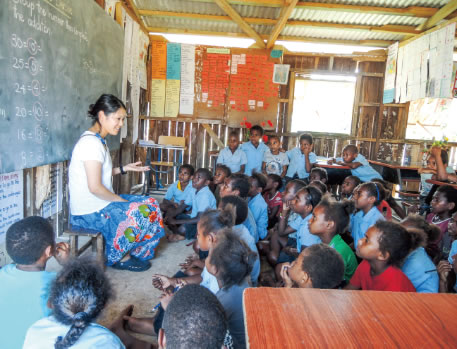
A mathematics class for second grade elementary school children in Vanuatu. Children pay close attention to the first lesson given by a Japan Overseas Cooperation Volunteer, Ms. Tamami Shimomura. (Photo: Tamami Shimomura)
Valuing “nation-building” and “human resources development,” Japan has been providing developing countries with a broad range of support for education, including the enhancement of basic education,* higher education, and vocational training.
At the timing of the UN Summit for the adoption of the 2030 Agenda in September 2015, Japan announced a new education cooperation strategy entitled, Learning Strategy for Peace and Growth. The new strategy was formulated to serve as a thematic policy in the field of education under the Development Cooperation Charter approved by the Cabinet in February 2015. In formulating the strategy, a wide range of views was exchanged with experts, NGOs, international organizations, and other parties. The new strategy aims to achieve quality education through mutual learning under the following basic principles: (i) Education cooperation to achieve inclusive and equitable quality learning; (ii) Education cooperation for industrial, science and technology human resources development and building the foundation of socio-economic development; and (iii) Establishment and expansion of global and regional networks for education cooperation. In the years ahead, Japan will further contribute to education assistance in accordance with the new strategy.
In March 2015, Japan and the United States unveiled the United States and Japan – Collaborating to Advance Girls Education Around the World, which contributes to promote assistance for the education of girls. Additionally, Japan contributes proactively to the discussions for formulating the framework for action that will succeed the EFA Framework for Action adopted in November 2015.
Also, with regard to the Global Partnership for Education (GPE),* which lays out the international framework for achieving universal primary education, Japan has actively participated in the discussions for formulating a new GPE strategic plan beyond 2016 and in the reform efforts. Furthermore, Japan’s contributions to GPE funds from FY2007 to FY2015 totaled approximately $22.8 million.
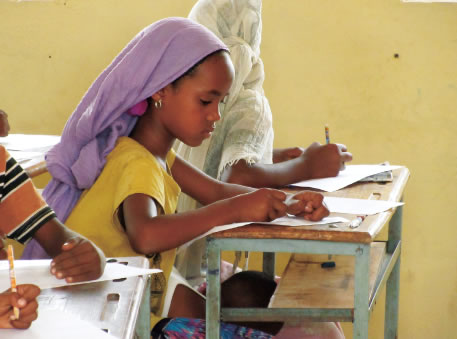
Children take their end-of-term test at Duwaw Primary School, which primarily accepts orphans in Awash Sabat Kilo Town located in the Afar Region in the eastern part of Ethiopia. (Photo: Ayumi Hama / Embassy of Japan in Ethiopia)
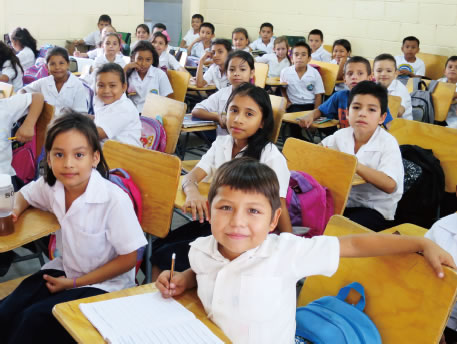
The Dionisio de Herrera Education Center in San Pedro Sula, Cortez, located in the northwestern part of Honduras in Central America. Children are studying at the school building rebuilt with the assistance of Japan. (Photo: Hiromi Sakai / Embassy of Japan in Honduras)
Regarding initiatives for Africa, at TICAD V held in June 2013, Japan announced that it would provide quality educational environments for 20 million children over the course of five years starting in 2013, through the expansion of support for math and science education improvement and school management improvement projects. Japan is steadily implementing these initiatives.
In addition, at TICAD VI held in August 2016 Japan announced that it would train approximately 20,000 science and mathematics teachers over the course of three years starting in 2016, contributing to strengthening basic academic skills in science and technology.
Furthermore, in order to contribute to the development of education and the improvement of its quality in the Asia- Pacific region, Japan established Funds-in-Trust within the United Nations Educational, Scientific and Cultural Organization (UNESCO) to implement projects for improving the operational capacity of community learning centers for literacy education, among other purposes.
In Afghanistan, an estimated 11 million people (about 30% of the population over the age of 15) are illiterate (Note 19) due to the impact of nearly three decades of civil war. Therefore, the Government of Afghanistan advances literacy education for the people. Japan has contributed to the promotion of literacy education in Afghanistan by extending a total of approximately ¥5.3 billion in grant aid through UNESCO since 2008, which provided literacy education to 1 million people in 100 districts of 18 provinces in Afghanistan.
In recent years, Japan has been promoting transnational networking of higher education institutions and joint research projects among neighboring countries. Japan also supports human resources development in developing countries by accepting international students to Japanese institutions of higher education and other institutions in accordance with the 300,000 International Students Plan and through other such measures.
In Kenya, the Institute of Tropical Medicine, Nagasaki University established the Kenya Research Station in 2005 which is developing research activities pertaining to tropical infectious diseases, global health, etc. Through these activities, the research station accepts Kenyan and Japanese undergraduate, masters and doctoral students to develop researchers and other core human resources to lead healthcare in Africa in the future. Furthermore, health education for children is provided and regional health activities are put into practice through the school health activities of JICA Partnership Program.
In addition, Japan strives to make it easier for Japanese in-service teachers to go overseas as Japan Overseas Cooperation Volunteers (JOCV) or Youth Volunteers for Nikkei Communities through the Special Program for School Teachers.* In-service teachers dispatched to developing countries contribute to educational promotion and development in their countries of destination, and make use of their experiences as volunteers in the Japanese educational context upon their return to Japan.
- * World Education Forum 2015
- World Education Forum 2015 is an international education conference held in Incheon, the Republic of Korea in May 2015. Attended by the UN Secretary-General, education ministers, and high-level officials, the conference discussed education beyond 2015 and adopted the Incheon Declaration on the final day. During the conference, the Japanese government delegation called upon members to promote Education for Sustainable Development (ESD), among other actions.
- * Education for All (EFA)
- EFA is an international movement aimed at ensuring everyone in the world has the opportunity to receive at least basic education. The five main organizations involved in EFA are UNESCO, the World Bank, UNDP, UNICEF, and the United Nations Population Fund (UNFPA), with UNESCO serving as the overall coordinator.
- * Education 2030 Framework for Action
- This framework for action succeeds the EFA Dakar Framework for Action aimed at achieving education for all, adopted at the World Education Forum in Dakar, Senegal in 2000 with a target date of 2015. The Education 2030 Framework for Action was adopted at the Education 2030 High-Level Meeting, which was held to coincide with the UNESCO General Conference in November 2015.
- * Basic education
- Basic education is educational activities designed to enable individuals to acquire the knowledge, values, and skills needed to live. It mainly refers to primary education, lower secondary education (equivalent to Japanese junior high school), pre-school education, and adult literacy education.
- * Global Partnership for Education (GPE)
- GPE refers to a framework for international cooperation established under the leadership of the World Bank in 2002, in order to achieve universal primary education by 2015 that was included in the MDGs and the EFA Dakar goals (formerly known as Fast Track Initiative [FTI]).
- * Special Program for School Teachers
- The program enables teachers of Japanese public or private schools to participate in the JOCV program or the Youth Volunteers for Nikkei Communities program while remaining affiliated with their schools. It is designed to facilitate in-service teachers’ participation in international cooperation. Teachers who are recommended by MEXT to JICA are exempt from the preliminary technical test. The period between the pre-dispatch training and the termination of dispatch is two years (compared to the usual two years and three months), beginning in April and ending in March to match the Japanese school year.
- Note 18: Source UN “The Millennium Development Goals Report 2015”
- Note 19: Source UNESCO, 2015
•Cambodia
The Project for Educational Resource Development in Science and Mathematics at the Lower Secondary Level
Technical cooperation project (May 2013-May 2016)
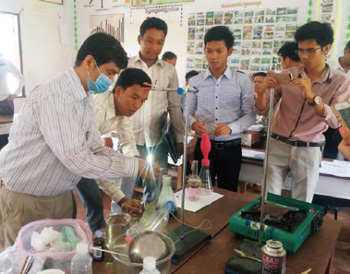
Training on experimentation methods in a chemistry class for teachers. The teachers perform the experiments with deep interest. (Photo: JICA)
Cambodia lost all of its competent personnel such as teachers and intellectuals, due to the mass genocide from 1975 to 1979 by the Pol Pot regime and saw the collapse of its human resource development system. Thereafter, Cambodia tried to revitalize the nation. Although the expansion of the education has progressed in quantity, problems with quality have remained.
Under such circumstances, in 2000 Japan implemented the Secondary School Teacher Training Project in Science and Mathematics (STEPSAM1, 2000-2005), as the first technical cooperation project related to science and mathematics education in Cambodia. STEPSAM1 strengthened the capabilities of science and mathematics teachers of the National Institute of Education (NIE) which is the training institution of high school teachers, and provided training for incumbent teachers of science and mathematics in high schools. Furthermore, NIE teachers were dispatched to Japan to study for college degrees and diplomas, and Japan provided support for the improvement of the functions and capabilities in the science and mathematics fields of NIE. Furthermore, following STEPSAM1, the Science Teacher Education Project (STEPSAM2, 2008-2012) was implemented to strengthen the capabilities of teachers in charge of the science curriculum from teachers’ training colleges (a total of 24 colleges) for elementary and secondary school education.
The Project for Educational Resource Development in Science and Mathematics at the Lower Secondary Level (STEPSAM3, 2013-2016), following STEPSAM2, provided instructions on how to improve teaching at lower secondary schools in six target provinces using guidance books developed for teachers of lower secondary schools. A total of 17,000 teachers participated in the series of training sessions and approximately 50,000 copies of the guidance books were distributed. These guidance books were highly evaluated by the Ministry of Education, Youth and Sport, and it was decided to implement training sessions and distribute guidance books in 19 other provinces on the budget of the Royal Government of Cambodia.
The cooperation in the science and mathematics education fields that initially began with the support for only 20 NIE teachers has grown over the past 16 years to such an extent that the outcomes are delivered directly to science and mathematics teachers in lower secondary schools nationwide. During that time, NIE teachers began to give instruction to the instructors in teachers’ training colleges and the instructors of teachers’ training colleges are actively working as instructors for the training of incumbent teachers. Now, people who were involved in STEPSAM have taken up responsible positions within the Ministry of Education, Youth and Sport, and are advancing the reform of science and mathematics education on their own initiative.
•Nepal
The Follow-up Cooperation on the Projects for Construction of Primary Schools in Support of Education for All (Phase Ⅰ & Ⅱ) and School Sector Reform Program in Nepal
Grant aid (August 2015 – September 2016)
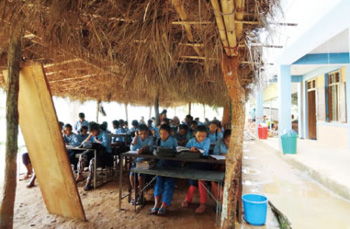
A lesson in a temporary classroom. School restoration work is underway in the background. (Photo: JICA)
Due to the earthquake in Nepal that occurred on April 25, 2015 and the aftershock on May 12, many schools suffered damage. In response to this, Japan commenced support for restoring the school buildings in early July. However, it was likely that it would take some time to implement full-scale support. Therefore, in order to avoid delay for the support and meet local needs quickly, Japan commenced the restoration work one by one for 230 classrooms of schools in Dhading District, Gorkha District and Nuwakot District among those for which Japan has implemented assistance in building schools with grant aid in the past nearly 20 years.
Schools resumed their class after the earthquake disaster but repair and reconstruction of the classrooms was delayed, which made many schools hold classes in makeshift places such as temporary classrooms or tents. What was worse, the local rainy season after the earthquake running between June and September made it difficult to completely prevent rain leaking through the roof of the temporary classrooms built with bamboos and tents and use of such classrooms was impossible in the medium- to long-term. The principal of Indrayani primary school, one of the schools to be restored, said “I am grateful to all the relevant people who came from Japan to ascertain the status of the damaged school buildings after the earthquake and promptly achieved cooperation for the restoration” with reference to the fact that Japan implemented restoration work even during the rainy season.
Together with this restoration project, through the Emergency School Reconstruction Project, a loan assistance project, Japan is also working, through joint-financing with the Asian Development Bank (ADB), *1 on the reconstruction and enhancement of quake-resistance of school buildings in the 14 districts that were particularly damaged in the earthquake. Through the classroom restoration project, Japan has been delivering a safe learning environment to children by offering seamless support for the full-scale reconstruction of schools.
*1: ADB was established under the initiative of Economic and Social Commission for Asia and the Pacific (ESCAP) with the objective of contributing to the economic development of developing countries by supporting their economic growth and economic cooperation in the Asia and Pacific region.
